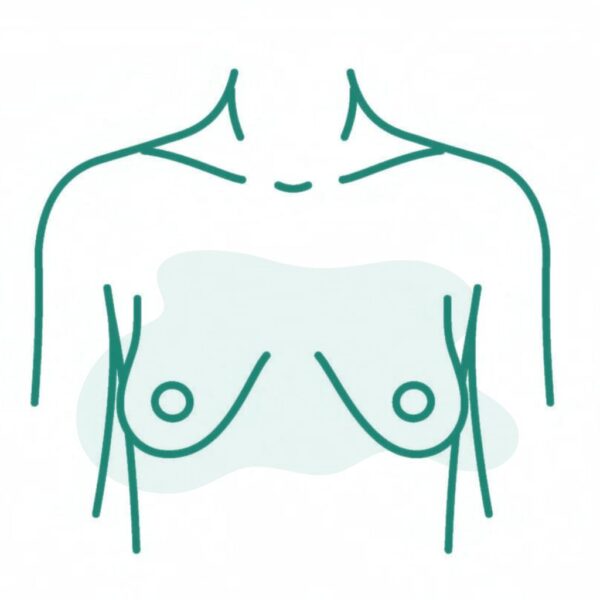Tuberous breast deformity is a recognised developmental condition that can affect the shape, structure, and proportion of the breasts. Dr Gary Kode, Specialist Plastic & Reconstructive Surgeon based in Melbourne, offers individualised care for patients seeking surgical treatment for this condition.
Dr Kode’s approach involves detailed planning, tailored surgical techniques, and a focus on outcomes that align with each patient’s physical characteristics and goals. Recognising the unique considerations of this procedure, he provides thorough guidance and clear communication throughout the treatment process.
Understanding Tuberous Breast Deformity
Tuberous breast deformity, also known as constricted breast deformity, is a recognised developmental condition where breast growth is restricted during puberty. Rather than expanding evenly, breast tissue remains tight or underdeveloped, particularly in the lower portion of the breast. Features of tuberous breasts may include:
- Narrow breast base: The breast may appear narrow or constricted relative to the chest wall, often with limited forward projection. This can result in a flat or tight appearance and uneven volume distribution.
- Elevated inframammary fold: The crease beneath the breast (inframammary fold) may sit higher than usual, reducing the breast’s vertical length and contributing to a “high-riding” or shortened breast shape.
- Prominent areola: Herniation of glandular tissue can cause the areola to bulge outward, giving it a prominent or swollen appearance that draws attention to the central breast area.
- Asymmetry: One breast is often more affected than the other, leading to visible differences in size, shape, or nipple position. This asymmetry can range from slight to significant.
- Deficient lower breast tissue: The lower breast (lower pole) may lack volume or fullness, which contributes to the tight, constricted appearance and alters overall breast shape.
Tuberous breast deformity exists along a spectrum. A thorough clinical evaluation by an experienced surgeon, like Dr Kode is vital to understanding the specific features present.
Surgery/Treatment Options for Tuberous Breasts
Surgical strategies are tailored to the individual grade and features of each tuberous breast presentation. Dr Gary Kode may recommend one or more of the following techniques:
- Tissue Scoring: Strategically placed internal incisions are made within the tight breast tissue to release constricted fibrous bands. This allows the breast to expand, laying the groundwork for reshaping through augmentation or fat transfer.
- Breast Fold Repositioning: When the inframammary fold sits higher than expected, it is surgically lowered to help release the breast base. This repositioning supports a balanced lower pole and contributes to overall breast symmetry.
- Areolar Reduction: In cases of herniated or enlarged areolas, a circular incision is made to reshape and resize the areolar complex. This helps with the central breast proportion and alignment.
- Breast Implant Placement: An appropriately selected implant can alter the breast shape, projection, and volume. Dr Kode typically uses a subglandular (above the muscle) placement in tuberous breast cases, supporting long-term outcomes without interfering with chest muscle function.
- Fat Grafting: Fat is harvested from another part of the body, processed, and placed into the breast to add volume where needed. This is especially useful for softening the transition between implant and breast tissue or addressing slight asymmetries.
Each component of the procedure is selected based on a thorough assessment of the patient’s anatomy, skin characteristics, and treatment goals.
Single-Stage vs Staged Surgery
In mild to moderate cases, a single operation may be sufficient to release constriction, reshape the breast and add volume. For more complex presentations involving significant tissue tightness, asymmetry, or volume discrepancies, a staged surgical plan may be recommended.
In a staged approach:
- The first surgery focuses on tissue release and expansion.
- The second procedure may further alter the shape, increase symmetry, or adjust volume once the tissues have adapted.
During consultation, Dr Kode will explain which approach may be most suitable for your anatomy and goals, supporting informed decision-making.
Recovery and Post-Operative Care
Recovery following tuberous breast surgery varies from person to person and depends on the techniques used during the procedure. Most patients can expect some bruising, swelling, and discomfort in the initial days after surgery. These effects typically ease over the first couple of weeks.
Dr. Gary Kode will provide detailed aftercare instructions, including guidance on wound care, wearing support garments, and activity restrictions. You may need to avoid strenuous exercise and heavy lifting for several weeks. Follow-up appointments are scheduled to monitor healing and address any concerns that arise during the recovery period.
It’s important to follow all post-operative advice closely, attend all reviews, and contact the clinic if you experience unexpected symptoms or have questions during your recovery.
Recovery experiences vary based on individual factors such as tissue quality, procedure complexity, and healing response.
Potential Risks and Complications of Tuberous Breast Surgery
All surgical procedures carry potential risks, and Tuberous Breast Surgery is no exception. During your consultation, Dr. Gary Kode will discuss these with you in detail, including how they relate to your personal health history and surgical goals. Some potential risks and considerations include:

- Infection: Any surgical site can become infected. Preventative steps such as sterile technique, antibiotics where appropriate and careful post-operative care are used to reduce this risk.
- Poor scarring: Scars may be noticeable or may heal differently from side to side. In some cases, raised, keloid or stretched scars can develop.
- Asymmetry: Differences in breast size, shape, or nipple position may remain or develop over time.
- Changes in sensation: Temporary or long-term changes in nipple or breast sensation can occur.
- Implant-related concerns (if implants are used): These may include implant rupture, capsular contracture, or implant malposition.
- Fluid build-up (seroma) or fat necrosis: In procedures involving fat grafting or extensive tissue work, these outcomes are possible.
- Need for further procedures: Some patients may require or choose to undergo additional surgery in the future.
Dr. Kode takes time to explain all relevant risks during your consultation, helping you make an informed decision with a clear understanding of both the potential benefits and limitations of the procedure.
For more information visit our Risks and Complications page.
Consultation and Personalised Surgical Planning
Your consultation is an important step in exploring treatment options. When meeting with Dr Gary Kode in Melbourne, patients can expect:
- Thorough medical review: Including, health history, previous surgeries, breast development, and lifestyle factors relevant to planning a surgical approach and anaesthesia.
- Detailed physical assessment: Measurements of breast base, nipple position, skin condition, and inframammary fold height are recorded. Any asymmetry is noted to guide a personalised plan.
- Open discussion about goals: Patients are invited to share concerns and preferences.
- Customised surgical options: Based on your anatomy, Dr Kode will outline potential surgical approaches and the reasons for each method considered.
- Balanced information on risks and potential outcomes: Possible complications, including scarring, asymmetry, and need for further procedures, are explained in clear terms.
Dr. Kode does not apply a standard template for Tuberous Breast surgery. Each surgical plan is tailored to:
- The degree of tissue constriction, from mild to more complex cases that may require staged procedures.
- The characteristics of skin and breast tissue, which affect technique and implant options.
- The patient’s desired breast shape, size, and symmetry, with attention to what can be reasonably achieved given the anatomy.
Surgery for tuberous breasts aims to address shape and proportion differences, but results vary depending on individual tissue characteristics and healing responses. Some asymmetry may persist, and further procedures could be required over time. Dr. Kode’s extensive experience and hands-on approach to consultation, surgery, and follow-up care provide patients with personalised treatment and consistent support. He prioritises clear communication to assist patients in understanding the potential results and risks involved.
FAQs About Tuberous Breast Surgery
Next Steps
If you have concerns about breast shape or suspect you may have tuberous breast characteristics, a consultation with Dr Gary Kode can provide further clarity. During this appointment, he will assess your individual presentation, discuss suitable surgical options, and outline what to expect before, during, and after the procedure. To learn more or to book a consultation at Dr Kode’s Melbourne practice, please contact our team.
Further Reading
- Read more about Breast Augmentation Melbourne
- Read more about Fat Transfer to Breast Melbourne


